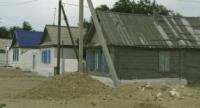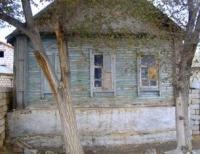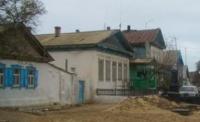You are here
History of village of Bautino.



Excursion to Bautino in Mangistau region.
“I never think about the future. It comes soon enough.”
Albert Einstein.
Tours from Astrakhan to Aktau.
The village of Bautino is located three kilometers from the regional center of Fort Shevchenko. State officials say that the village is “registered”, sailors say “assigned” to Fort, pilots say that Bautino is a satellite village of the city of Fort Shevchenko.
The village is special in everything, starting with the appearance. The hallmark of the village are bleached mud huts with light carved shutters. The eye, tired of the routine of geometric proportions, pleasantly stops at these freshly whitewashed houses, as well as the branched centuries-old elms that adorn the village, inspiring unforgettable impressions of antiquity.
The warm sea wave of the Tupkaragan Gulf gently splashes on the sloping shores of the coast, which stores the enormous secrets of people who lived on the coast at different times and eras. The village of Bautino was founded as the village of Nikolaev in 1849.
Thanks to the employee of the Museum-complex named after T. Shevchenko N.Sh. Suin, we got acquainted with the most interesting document preserved in the museum. This is a historical essay "The Village of Nikolaev" by priest Nikolai Zverev, written in 1907.
We turn over only a few pages of this manuscript: “The village of Nikolaevskaya is located on a sand spit, which stands out from the Mangyshlak Peninsula with a narrow strip running parallel to the coast of the peninsula to the Caspian Sea, to the Tupkaragan Bay, which is very convenient for ship parking...
Since ancient times, the owners in the Transcaspian Region in The northern half of the Mangyshlak Peninsula was Kazakh, and the southern half was Turkmen. When this land was conquered by the Russians, the Novopetrovsk fortification, renamed Fort Alexander, was built to maintain power in its citizenship three miles from Tupkaragan Bay.
To populate the desert Tupkaragan region, to develop fishing on the eastern coast of the Caspian Sea, by the highest command, a call was made to hunters from the Cossacks of the Orenburg province. Five Cossack families eagerly responded to this call and, tearing themselves away from their native land, according to the sovereign's first word, went off to an unknown destination.
They settled on the sandy spit of Tupkaragan Bay, forming here the first Russian settlement - the village of Nikolaevskaya. Nearby grew an Armenian settlement. The Armenians quickly began to trade. ” And now let us turn to the equally important historical document of the military governor General Obruchev, which says:
“The settlement of Mangyshlak by Russians has a double meaning. Firstly, for the spread of trade relations with Khiva and Bukhara and for barter trade with the Horde (i.e., Kazakhs and Turkmens), wandering on the eastern shore of the Caspian Sea. Secondly, for the development of fisheries and seals.”
In 1848, for the development of trade in Mangyshlak, the goods of Russian merchants were exempted from any duty, and all Russian subjects were allowed to conduct free exchange trade. We return again to the sketch of Zverev.
We learn from it that at the beginning of 1849 15 families came from the Orenburg and Saratov provinces. Dedurins, Perpelyukovs, Sevryutkins, Elistratovs, Yazykovs, two families of the Razumanovs and Belunins, Chermyshnikovs, Dankovs, Savchenki, Krivokhizhina and Lomakina.
The Russian government issued log huts to all newcomers. They were put and laid by stoves, soldiers serving in the Fort Alexander Fortification. Together with houses, for each family, a equipped pod with sails, ropes and anchors was sent and 70 rubles for fishing tackle were issued.
New settlers were given government rations, full for adults, and half for children. In addition, the commandant of Fort Aleksandrovsky gave the settlers nails, staples, tar, firewood, salt, coolies with flour - in a word, he helped to get on his feet and acquire an economy.
In 1858, 12 volunteer families arrived from the Orenburg province to the village of Nikolaevskaya. In 1859, two more families arrived, Dubsky and Posadsky. They had to build houses themselves and settle in with households, fishing tools at their own expense.
Clay and stone for the construction of dugouts were taken in the mountains, behind the bay, and transported on piers. The owners themselves molded for themselves dugouts from broken shell rock, smeared them with clay, the roofs also smeared clay.
Such roofs did not protect the inhabitants of dugouts from rain. The floors were mostly earthen, oiled with clay ... Very soon, the settlers realized that fishing would be their only livelihood. To make life possible in this desert region, the Russian government granted the following favors: free fishing in all official waters of the Caspian Sea until 1869, exemption from military service and state taxes until 1904, free mining of salt from local salt lakes of 150 pounds per family.
Some families who came without sovereign support were unable to settle down and feed themselves and were forced to leave for more settled and fertile lands. By applicant the fortifications of 40 families who wished to leave were resettled in the Kuban region, closer to Elbrus; they were ranked among the Cossack class.
The area where these families were sent was fertile. However, a fever raged on her, and people died like flies. Moreover, the exhausted inhabitants were also forced to protect their huts from the raids of wild mountaineers. Six years later, the remaining migrants returned back to Nikolaevskaya village.
By this time, people came to the village not only from the Orenburg region, but also from other provinces of Russia ... With the help of the Russian government, as well as with God's help, the settlers built the first 15 stone houses. The little Nikolaev settlers managed to earn a little by fishing.
Mangyshlak fish was less expensive than Astrakhan fish. And it was impossible to engage in the cultivation of vegetables and fruits that was familiar to them - the land was salty and fresh water was worth its weight in gold. As for the village, so in those bloody "70s" of the XIXth century of the "peasant uprising" many wooden houses were burned, others were plundered.
Some villagers were captured and sold into slavery in Khiva. But the persistent survived and continued their clan. The natural element of 1888 to check the resilience of the fishermen sent a strong storm, which took many boats and fishing gear to the sea.
The government was forced to provide support to the population by issuing bread and cereals from the Fort Aleksandrovsky Supply Store (Fort Shevchenko), as well as extending the benefits to the population until 1904. It was during these years, at the suggestion of Governor General Kuropatkin, the industrialist Zakhar Dubsky built a glacier that was of great importance for raising local fishing both in terms of improving the quality of fish preparation and increasing the price of it.
Dubsky and Trusov were reputed to be the best crackers in the village. The latter learned this business at Dubsky’s team, working with him for several years and looking at the secret of cooking. At the same time, Dubsky opened a small loan to the catchers.
After that, the welfare of the local population increased sharply. Transport was scarce - there were only four horses in the entire village. And it means, it was difficult for nikolayevets to communicate with inhabitants of other villages of the peninsula.
They lived their little world on the coast of Tupkaragan Bay, so they were happy, married, gave birth to children and blessed them for life in their native village. The village was named after Alexey Bautin on July 2, 1921, the village of Nikolaevskaya in honor of the first chairman of the Council of Deputies, Alexei Egorovich Bautin, was renamed the village of Bautino.
In the center of the village of Bautino there is a concrete pedestal on which a granite slab is placed with the inscription: "To the first chairman of the council of deputies of the working people of the village of Nikolaevskaya, Bautin, Alexei Yegorovich, who died in 1919 at the hands of the White Guards."
Travelers do not pass by this stele, stop, curiously overcome the questions of local residents, who is this very Bautin. Any local resident will immediately say: "Bautin is a fighter for the establishment of Soviet power on the Tupkaragan Peninsula."
And the old-timer can tell some details from the life of this legendary person of the Soviet era. Aleksey Egorovich Bautin was from a poor Tambov family. After the revolution of 1905, his parents settled in the village of Nikolaev.
For ten years Aleksey was the laborer, and every day more and more often he thought about why the poor work from morning to evening, and do not instruct in work, and the rich urge and grow rich every day. During the First World War, he was actively carried away by revolutionary activities.
And in 1917, when the Council of Soldiers, Workers, Peasants and Muslim Deputies was formed in Fort Shevchenko, a little later, in the spring of 1918, in the village of Nikolayevskoye, Alexei Yegorovich Bautin was elected chairman of the Nikolaev village council, as well as the commander of the red company.
Bautin was active in establishing Soviet power on the Tupkaragan Peninsula. On the basis of the fishing industry, Dubsky organized the first labor artel, took an active part in organizing food centers for the poor, in acquiring cows for feeding the weakened children of the village, etc.
His work was appreciated by the Communists, and in 1919 he was enlisted in the Bolshevik party. Someone said that the heroes are checked by time, and real heroes - more than once. So, in May 1919, an English squadron broke into Tupkaragan Bay, as well as a White Cossack detachment under the leadership of General Zheleznov, and with it a military court led by Colonel Dynnikov.
The protégés of the counter-revolution inflicted brutal reprisals against Soviet activists. Seeing the inequality of forces, the Soviet authorities decided to temporarily leave the peninsula. And Alexey Bautin, along with his comrades, decided to leave for Astrakhan on a small sailing boat. People say that Zakhar Dubsky, a Tupkaragan fisheryman, also participated in saving Bautin.
But the wind died down, and the sail, not inspired by the sea wind, sagged. The Belokazaki, who organized the chase, quickly overtook the fugitives. The general 70 officers and more than 1000 white Cossacks. Only a few squirrels managed to escape from deserved punishment.
So, on April 6, 1920, Soviet power was finally established. Valuable recollections of the daughter of Alexei Bautin, Maria, have been preserved: “When my father was in prison, I was small and out of pity, I was allowed to visit my father for several times.
One day, my father put a note under the insole of my shoe, in which he informed his comrades who remained at liberty that Andrei Yuvko, commander of the Red Army, was in the cell with him. As I recall now, a gathering near the house of the merchant Dubsky, where the Bolsheviks were being tried.
Dubsky said that they might feel sorry for Bautin, he has four children, but someone in the crowd made a noise and protested. They decided - to be shot. In the morning, the elder sister, Proskovya, carried a transmission to the prison and saw a soldier dressed in his father's.
We understood that the sentence was carried out... They were shot not far from the seashore. They did not let us down to the grave. Only later, at night, Sapozhnikov, who was only released from prison, led us ashore to the grave of his father and Yuvko. It was a terrible sight.
The executed were almost not buried. After the expulsion of the white father, T. Shevchenko was reburied in the park. After suffering, the mother soon died. There are four of us left. Alexandra went to the workers, I'm in a boarding school. Arkady was sheltered in the Romanov family.
Then we were placed together in a boarding school in Uralsk. In 1926, I returned to the village, which bore the name of my father. I got a job at the outpatient clinic. Sheltered me in a wonderful family Balashov. Two years later, I married the son of Dmitry Ivanovich Balashov.
So for me the house of the Balashovs became parental. ” Documents of June 2, 1921, in particular, protocol No. 2 of the meeting of the second county Adaev party conference (chairman T. Motchanov, secretary Komisarenko) tells that the agenda included the question of renaming the city of Fort Aleksandrovsky to the city of Fort Uritsky, and village of Nikolaev in the village of Bautino.
It was decided to rebury the remains of Bautin, Yuvko and other residents who died in the struggle for Soviet power in a city park, as well as to build a monument on a mass grave. ” In a city park in a festive atmosphere, the heroes of the revolution were reburied.
Street, school, village were named after Bautin. Years later, in 1957, an obelisk was installed on the mass grave in the city park. By the decision of the local party and Soviet bodies in 1958, the house was built and transferred for free use to the daughter of the Soviet hero, Maria Alekseevna Bautina.
And here is another letter from past years that sheds bright light on the glorious name of one of the selfless fighters of the revolution, A. Bautin. This letter was written by Maria Mikhailovna Bogdanova and addressed to Bautin’s daughter, Maria Alekseevna:
I owe my life to Alexei Yegorovich. In 1918, my husband and I worked in the Fort Aleksandrovsk fortress and was a Bolshevik agitator. When the whites came from Guryev, your father helped me and my husband avoid the execution. I couldn’t avoid her myself.”
The activity and life of Alexei Yegorovich Bautin was short-lived, but bright. In the old archives, time-worn books of past years, events, facts that left an indelible mark on the memory of the people are stored and among them Alexey Egorovich Bautin occupies a worthy place.
The first secretary of the Central Committee of the Communist Party of Kazakhstan D.A. Kunaev correctly said: “Centuries will pass, but the names of staunch fighters for Soviet power will never be erased in the memory of future generations.
We bow our heads to the blessed memory of those who gave their lives for freedom, bravely fought for the triumph of the cause of the revolution."
Athority:
Natalia Zaderetskaya. "Tupkaragan is the cradle of Mangistau."
Photos
Alexander Petrov.







